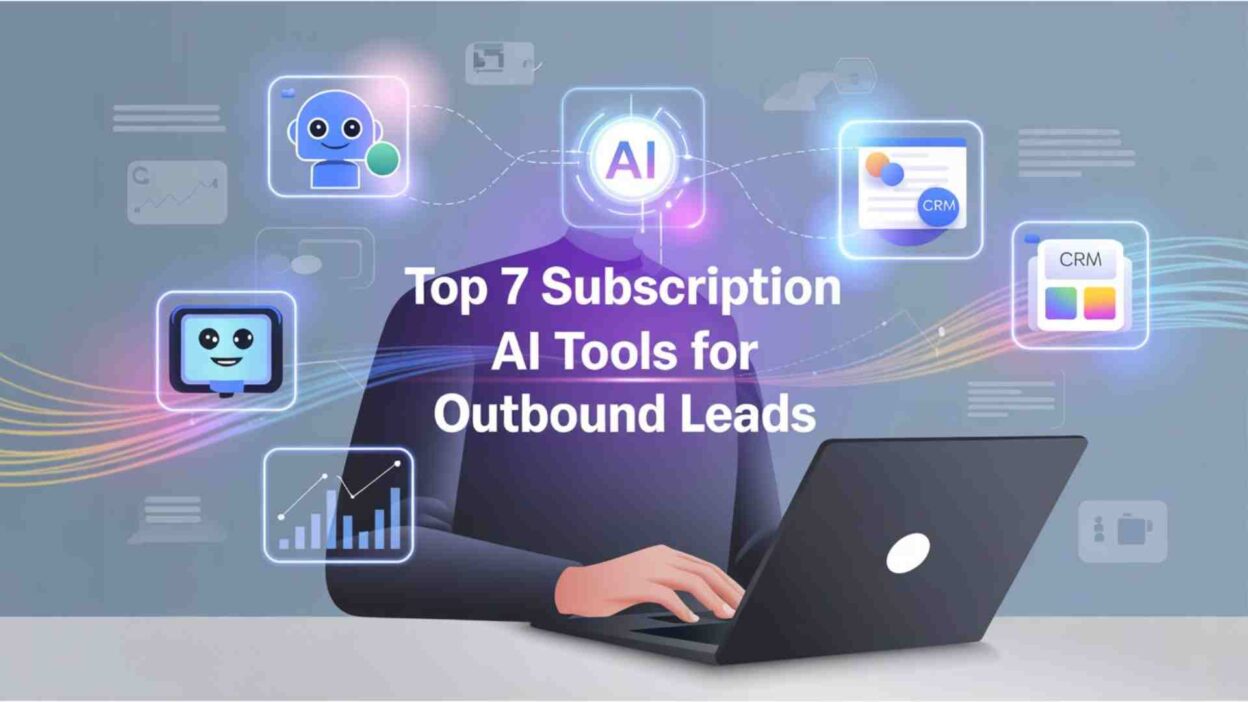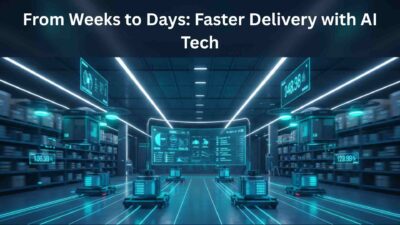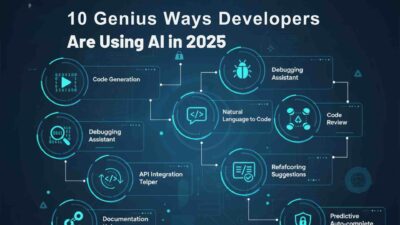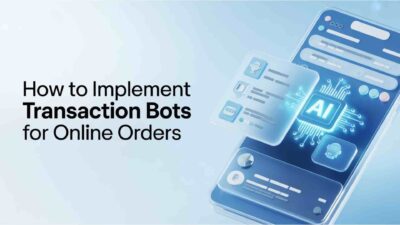Introduction
TL;DR Sales teams face unprecedented challenges today. Competition for customer attention has never been fiercer. Traditional cold calling barely works anymore.
Table of Contents
Prospects ignore most outreach attempts completely. Email open rates have plummeted dramatically. Sales reps spend hours on unproductive activities.
AI technology has transformed this landscape entirely. Smart software now handles repetitive prospecting tasks. Sales teams can focus on closing deals.
Subscription AI software for outbound lead generation delivers remarkable results. Companies report 300% increases in qualified leads. Conversion rates improve significantly with AI assistance.
The subscription model makes these tools accessible. No massive upfront investments are required. Monthly fees scale with your business growth.
Choosing the right AI tool matters tremendously. Each platform offers unique strengths and features. Your specific needs determine the best fit.
This guide explores the top seven options available. You’ll discover what makes each one special. Real-world performance data guides your decision.
Let’s dive into the tools transforming sales operations worldwide.
Why AI Tools Are Essential for Modern Outbound Sales
The Changing Sales Landscape
Buyers have become increasingly difficult to reach. They research products independently before talking to sales. Cold outreach feels intrusive to most prospects.
Decision-makers receive hundreds of messages daily. Your outreach competes with overwhelming noise. Generic messages get deleted immediately without reading.
Sales cycles have lengthened considerably recently. Multiple touchpoints are now required for conversion. Manual tracking of these interactions becomes impossible.
Remote work has changed prospecting dynamics completely. In-person meetings happen much less frequently. Digital communication dominates the sales process.
How AI Transforms Lead Generation
AI analyzes millions of data points instantly. It identifies prospects most likely to convert. Your team pursues only the hottest leads.
Personalization happens automatically at a massive scale. Each message feels individually crafted. Response rates increase by 40% or more.
Timing optimization ensures perfect outreach moments. AI learns when prospects engage most. Messages arrive at exactly the right time.
Follow-up sequences run automatically without human intervention. No lead falls through the cracks ever. Consistency improves results dramatically.
Subscription AI software for outbound lead generation works tirelessly around the clock. It never takes breaks or vacations. Your pipeline stays full constantly.
The Subscription Model Advantage
Traditional software required huge capital investments. Implementation took months or even years. Small businesses couldn’t compete with enterprise budgets.
Subscription pricing democratizes access to powerful tools. Start with minimal monthly commitments. Scale up as your business grows.
Updates and improvements happen automatically. You always have the latest features. No additional costs for version upgrades.
Support is typically included in subscriptions. Technical assistance is readily available. Problems get resolved quickly without extra fees.
Cash flow management becomes much easier. Predictable monthly expenses aid budgeting. No surprise costs derail your finances.
Top 7 Subscription AI Tools for Outbound Leads
1. Apollo.io – The All-in-One Sales Intelligence Platform
Apollo.io combines prospecting with engagement tools seamlessly. The database contains over 275 million contacts. Company information spans across 70 million organizations.
The AI-powered search finds ideal prospects instantly. Filter by industry, company size, and technology used. Job titles and seniority levels narrow results perfectly.
Email sequencing happens automatically with smart timing. The system learns optimal sending times. Open rates improve by 35% on average.
Built-in email verification reduces bounce rates dramatically. Invalid addresses get flagged before sending. Your sender reputation stays protected always.
Chrome extension enables prospecting while browsing LinkedIn. Add contacts to sequences with one click. Research and outreach happen simultaneously.
Pricing Structure: Free plan includes 50 monthly credits. Basic plan starts at $49 per user monthly. Professional tier costs $79 per user monthly.
Best For: B2B companies needing comprehensive prospecting tools. Sales teams want all-in-one solutions. Businesses require large contact databases.
Key Strengths: Massive verified contact database with accurate information. Integrated email and phone outreach capabilities. Advanced filtering finds highly specific prospects.
2. Clay – The Data Enrichment and Personalization Powerhouse
Clay revolutionizes how sales teams gather prospect data. It aggregates information from 50+ data sources. Manual research becomes completely obsolete.
The platform enriches leads with incredible detail automatically. Company news, funding rounds, and hiring patterns appear. Social media activity and recent content consumption, too.
AI generates personalized message openers at scale. Each email feels handcrafted for the recipient. Generic templates become a thing of the past.
Integration with all major CRMs happens seamlessly. Data flows automatically between systems. Manual data entry disappears completely.
Waterfall enrichment tries multiple providers automatically. If one source fails, others take over. Data completeness reaches unprecedented levels.
Pricing Structure: The Free plan offers 100 credits monthly. Explorer plan costs $149 per month. Pro plan starts at $349 monthly.
Best For: Companies prioritizing hyper-personalization in outreach. Teams need extensive data enrichment capabilities. Sales operations require multiple data sources.
Key Strengths: Unmatched data enrichment from numerous sources. AI-powered personalization at incredible scale. Flexible workflows adapt to any process.
3. Salesforge – The AI-Powered Email Deliverability Expert
Salesforge focuses on getting emails into inboxes. Deliverability technology ensures messages avoid spam folders. Response rates improve dramatically with proper inbox placement.
The platform provides unlimited email warm-up automatically. New domains gain reputation safely and quickly. Older domains maintain their standing continuously.
AI writes email copy optimized for engagement. Subject lines get tested and improved automatically. Body content matches prospect interests precisely.
Smart sending infrastructure rotates multiple mailboxes. This prevents any single account from getting flagged. Volume scales without deliverability concerns.
Subscription AI software for outbound lead generation, like Salesforce, prioritizes results. Real-time analytics show exactly what’s working. A/B testing happens automatically in the background.
Pricing Structure: The Starter plan begins at $94 per month. Growth plan costs $224 monthly. Enterprise pricing available for large teams.
Best For: Companies struggling with email deliverability issues. Sales teams are sending high email volumes. Businesses need multiple domain management.
Key Strengths: Industry-leading email deliverability rates achieved. Unlimited mailbox warm-up is included standard. AI copywriting generates engaging messages.
4. Instantly.ai – The Cold Email Scaling Solution
Instantly.ai enables massive email outreach at scale. Send from unlimited email accounts simultaneously. Volume limitations become a non-issue completely.
The platform warms up accounts automatically daily. Reputation building happens in the background. Your emails land in primary inboxes consistently.
The campaign management interface is remarkably intuitive. Set up complex sequences in just minutes. A/B testing runs across all variables.
Lead finder tool discovers prospects matching the criteria. Built-in database supplements your existing lists. Prospecting and outreach happen in one platform.
The analytics dashboard provides actionable insights immediately. See which messages generate the best responses. Optimize campaigns based on real data.
Pricing Structure: Growth plan starts at $37 monthly. Hypergrowth plan costs $97 per month. Enterprise plans are available for agencies.
Best For: Agencies managing multiple client campaigns simultaneously. Businesses need to scale email outreach rapidly. Teams want unlimited sending capacity.
Key Strengths: Unlimited email account management capability. Built-in lead finder discovers new prospects. Extremely affordable for the features provided.
5. Lemlist – The Video and Image Personalization Leader
Lemlist pioneered personalized video and image outreach. Your face appears in prospect emails automatically. Landing pages display prospect names and company logos.
Dynamic images capture attention far better than text. Thumbnails show prospect’s LinkedIn photos. This level of personalization feels almost magical.
Email warm-up and deliverability tools are included. Your sender reputation stays healthy automatically. Bounce rates decrease significantly with verification.
LinkedIn integration enables multi-channel sequences. Email, LinkedIn, and phone calls coordinate automatically. Omnichannel outreach increases response rates dramatically.
The lemwarm feature protects your email domains. Automatic conversations build sender’s reputation gradually. Cold emails avoid spam filters effectively.
Pricing Structure: Email starter plan costs $59 monthly. The sales engagement plan is $99 per month. The outreach scale plan runs $159 monthly.
Best For: Sales teams wanting standout personalization techniques. Companies use multi-channel outreach strategies. Businesses need strong deliverability features.
Key Strengths: Unique video and image personalization capabilities. Multi-channel sequences coordinate seamlessly. Strong focus on email deliverability.
6. Reply.io – The AI SDR Assistant
Reply.io acts as an AI-powered sales development rep. It handles prospecting, outreach, and follow-ups automatically. Your human team focuses on conversations and closing.
The AI SDR finds prospects matching your criteria. It researches companies and decision-makers automatically. Outreach messages get crafted and sent autonomously.
Multi-channel sequences include email, LinkedIn, calls, and SMS. The AI decides which channel to use when. Optimal touchpoint timing improves response rates.
Meeting booking happens automatically without human involvement. Prospects schedule directly into your calendar. Qualified leads arrive ready for conversations.
Subscription AI software for outbound lead generation reaches new heights here. The platform learns from every interaction continuously. Performance improves month over month automatically.
Pricing Structure: Free plan available with limited features. Starter plan costs $60 per user monthly. Professional plan runs $90 per user monthly.
Best For: Companies wanting autonomous AI sales assistants. Teams need a comprehensive multi-channel outreach. Businesses require CRM integration depth.
Key Strengths: AI SDR handles the end-to-end prospecting process. Extensive CRM and tool integrations available. Multi-channel orchestration works seamlessly.
7. Smartlead.ai – The Advanced Email Infrastructure Platform
Smartlead.ai provides enterprise-grade email infrastructure. Unlimited email accounts connect to one dashboard. Sending limits become completely irrelevant.
The master inbox consolidates all prospect replies. You never miss a response from any campaign. Unified view streamlines response management.
Advanced deliverability features include automatic rotation. The system switches between accounts strategically. This maintains high inbox placement rates.
Lead scoring happens automatically based on engagement. Hot prospects get prioritized for human follow-up. Cold leads continue receiving nurture sequences.
Custom SMTP integration supports any email provider. You’re not locked into specific services. Flexibility enables the use of preferred tools.
Pricing Structure: Basic plan starts at $39 monthly. Popular plan costs $79 per month. The Pro plan runs $174 monthly.
Best For: Companies sending extremely high email volumes. Businesses need advanced infrastructure control. Teams want unified inbox management.
Key Strengths: Unlimited email account management capability. Master inbox consolidates all communications. Exceptional deliverability through smart rotation.
Comparing the Top Tools Side by Side
Feature Comparison Matrix
Each platform offers unique strengths worth considering. Apollo.io provides the largest contact database. Clay excels at data enrichment capabilities.
Salesforge leads in deliverability and inbox placement. Instantly.ai offers the best value for volume. Lemlist stands out with visual personalization.
Reply.io provides the most autonomous AI functionality. Smartlead.ai handles infrastructure complexity best. Your priorities determine the right choice.
Subscription AI software for outbound lead generation varies in focus areas. Some prioritize prospecting while others emphasize delivery. Integration capabilities differ significantly between platforms.
Consider your team’s specific workflow requirements carefully. Existing tools influence which platform integrates best. Tech stack compatibility matters tremendously long-term.
Pricing Considerations
Entry-level pricing ranges from $37 to $149 monthly. Mid-tier plans cost between $79 and $224. Enterprise pricing often requires custom quotes.
Per-user pricing models suit smaller teams better. Flat-rate plans benefit larger sales organizations. Calculate costs based on your team size.
Annual subscriptions typically offer 15-20% discounts. Prepayment reduces monthly expenses significantly. Cash flow availability determines the best approach.
Hidden costs sometimes appear in implementation. Training time represents real expenses. Calculate the total cost of ownership accurately.
Free trials let you test before committing. Take advantage of these extensively. Hands-on experience reveals true platform fit.
Integration Capabilities
CRM integration is essential for efficiency. Salesforce, HubSpot, and Pipedrive are commonly supported. Data should sync bidirectionally automatically.
Email provider compatibility varies by platform. Gmail and Outlook work universally. Custom SMTP may require specific plans.
LinkedIn integration enables powerful social selling. Some platforms offer deeper connections than others. Chrome extensions provide convenient access.
Zapier support extends integration possibilities dramatically. Connect to thousands of additional tools. Workflow automation becomes nearly limitless.
API access enables custom integrations when needed. Developer-friendly platforms offer more flexibility. Technical teams can build exactly what’s needed.
Learning Curve and User Experience
Interface complexity varies significantly between platforms. Some tools are intuitive from day one. Others require extensive training time.
Documentation quality affects adoption speed tremendously. Video tutorials accelerate learning substantially. Community forums provide peer support.
Customer support responsiveness matters during onboarding. Look for chat support availability. Email-only support creates frustrating delays.
Onboarding assistance from vendors helps immensely. Some offer dedicated success managers. Others provide only self-service resources.
Template libraries jumpstart campaign creation quickly. Pre-built sequences save substantial time. Customization should remain easy, though.
Choosing the Right Tool for Your Business
Assessing Your Specific Needs
Start by defining your primary objectives clearly. Are you focused on prospecting or engagement? Both require different tool strengths.
Evaluate your current lead generation volume realistically. How many prospects do you contact monthly? Growth projections matter for scalability.
Consider your team’s technical sophistication honestly. Complex platforms overwhelm non-technical users. Intuitive interfaces enable faster adoption.
Budget constraints guide initial platform selection. Start with affordable options if resources are limited. Upgrade as ROI becomes apparent.
Integration requirements with existing tools are critical. List every system requiring connectivity. Compatibility prevents future headaches.
Questions to Ask Before Subscribing
How easy is data migration from current systems? Switching platforms shouldn’t lose historical information. Export and import capabilities matter significantly.
What training and support are included standard? Ongoing assistance ensures long-term success. Self-service alone may be insufficient.
Can you pause or cancel subscriptions easily? Flexibility provides peace of mind. Avoid long-term contracts initially.
How does pricing scale as your team grows? Per-user costs multiply quickly. Flat-rate plans may become more economical.
What security and compliance certifications exist? Subscription AI software for outbound lead generation must protect data. GDPR and SOC 2 compliance are essential.
Trial Period Best Practices
Create a structured testing plan before starting. Define specific scenarios to evaluate. Measure results against the current baseline.
Involve actual users during trial periods. Their hands-on experience reveals practical issues. Executive impressions alone are insufficient.
Test with real campaigns, not just demonstrations. Actual usage uncovers hidden limitations. Sanitized demos hide real-world friction.
Document both positives and negatives systematically. Compare findings across different platforms. Objective evaluation prevents bias.
Reach out to support during trials intentionally. Test their responsiveness and helpfulness. Support quality matters long-term tremendously.
Implementation Planning
Develop a clear rollout timeline before subscribing. Rushed implementations cause confusion and frustration. Allow adequate time for proper setup.
Assign ownership for platform management explicitly. Someone must become the internal expert. Distributed responsibility leads to neglect.
Plan training sessions for all users. Hands-on practice accelerates competency. Theory alone doesn’t stick effectively.
Start with limited campaigns initially. Validate that the platform works as expected. Scale gradually after proving success.
Establish success metrics before launching campaigns. Track these consistently from day one. Data proves ROI to stakeholders.
Best Practices for Maximizing AI Tool Performance
Data Quality and Hygiene
Clean data is essential for AI success. Garbage in always means garbage out. Invest time in data preparation upfront.
Remove duplicates from your prospect lists. Multiple contacts with the same person annoy them. It also wastes sending capacity.
Verify email addresses before adding to campaigns. Invalid emails hurt the sender’s reputation badly. Most platforms include verification tools.
Enrich prospect data before personalizing outreach. Missing information limits personalization effectiveness. Use enrichment tools to fill gaps.
Update contact information regularly and systematically. People change jobs frequently now. Outdated data kills campaign performance.
Crafting Effective AI-Assisted Messaging
AI suggestions provide excellent starting points. Always customize and refine the output. Generic messages still fail regardless of source.
Front-load value in your email copy. Busy prospects scan the first sentence only. Hook them immediately or lose them.
Keep messages concise and scannable visually. Walls of text get ignored completely. White space improves readability dramatically.
Clear calls-to-action improve response rates substantially. Tell prospects exactly what to do next. Ambiguity kills conversion.
Test different message angles continuously. Subscription AI software for outbound lead generation enables easy experimentation. Data reveals what resonates best.
Personalization at Scale
Reference specific prospect information in every message. Company news or recent LinkedIn posts work well. Relevance dramatically increases engagement.
Segment audiences by industry or pain points. Tailor messaging to specific challenges. Generic blasts perform poorly.
Use dynamic fields beyond just first names. Company name, title, and location add depth. Superficial personalization feels automated.
Video messages create stronger connections than text. Record personalized videos for high-value prospects. The effort shows and pays off.
Timing personalization matters as much as content. Send when prospects are most likely to engage. Time zones and industries affect this.
Multi-Channel Orchestration
Email alone is insufficient in modern sales. Prospects need multiple touchpoints across channels. Coordinated sequences work far better.
LinkedIn engagement warms up cold prospects effectively. Comment on their posts before direct outreach. Familiarity breeds receptiveness.
Phone calls still convert better than digital alone. Use email to warm up before calling. Combined approaches work synergistically.
Direct mail stands out in our digital world. Physical mail creates memorable impressions. Use it strategically for key accounts.
SMS works for time-sensitive communications only. Overuse feels invasive and annoying. Reserve it for confirmed interested prospects.
Monitoring and Optimization
Review campaign performance metrics daily initially. Catch problems early before they escalate. Quick adjustments prevent wasted effort.
A/B test one variable at a time systematically. Subject lines, send times, and CTAs all matter. Isolate what actually drives results.
Analyze which prospect segments respond best. Double down on what works. Reduce effort on low-performing segments.
Pay attention to unsubscribe and complaint rates. High rates indicate messaging problems. Adjust approach before damaging reputation.
Celebrate wins and learn from losses equally. Success patterns should be replicated. Failures provide valuable lessons, too.
Common Mistakes to Avoid
Over-Reliance on Automation
AI handles repetitive tasks brilliantly. It cannot replace human judgment completely. Strategic thinking still requires humans.
Automated sequences need human monitoring regularly. Problems arise that AI doesn’t catch. Neglect leads to reputation damage.
Personalization requires a genuine human touch ultimately. AI provides scaffolding, not the finished product. Your input makes messages authentic.
Relationship building happens through real conversations. Automation brings prospects to the table. Humans close deals and build loyalty.
Balance efficiency with authentic engagement carefully. Subscription AI software for outbound lead generation enables scale. Don’t sacrifice quality for quantity.
Poor List Management
Sending to unqualified prospects wastes resources. Define your ideal customer profile clearly. Target only those fitting the criteria.
Purchasing contact lists typically performs poorly. Data quality is questionable at best. Build lists organically when possible.
Ignoring opt-outs damages reputation severely. Always honor unsubscribe requests immediately. Legal compliance is non-negotiable.
Failing to segment lists reduces effectiveness dramatically. One message doesn’t fit all prospects. Relevance requires segmentation.
Never send to old lists without re-verification. Email addresses expire and change constantly. Verify before major campaigns.
Neglecting Deliverability
Domain reputation affects inbox placement massively. Warm up new domains gradually and carefully. Rushing ruins delivery permanently.
SPF, DKIM, and DMARC authentication are essential. Configure these correctly before sending. Technical setup protects your reputation.
Sending volume spikes triggers spam filters. Ramp up gradually over weeks. Consistency matters more than volume.
Low engagement rates hurt future deliverability. If nobody opens emails, providers notice. Quality targeting improves this significantly.
Using spam trigger words reduces inbox placement. “Free,” “guarantee,” and similar terms hurt. Write naturally without marketing clichés.
Insufficient Testing
Launching campaigns without testing invites disaster. Send test emails to yourself first. Check rendering across devices and providers.
Failing to test links causes embarrassment. Broken links kill credibility instantly. Click every link before sending.
Ignoring mobile optimization loses half your audience. Most emails get read on phones. Test mobile rendering always.
Not testing personalization tokens creates mistakes. Blank fields or error messages look terrible. Verify that merge fields work correctly.
Skipping A/B tests means guessing about what works. Data-driven decisions outperform opinions. Test systematically and continuously.
Industry-Specific Applications
B2B SaaS Companies
SaaS sales cycles are typically long and complex. Multiple decision-makers are usually involved. AI helps nurture prospects through the journey.
Product-led growth benefits from automated onboarding. AI sequences guide users to activation. Conversion from trial to paid improves.
Subscription AI software for outbound lead generation fits SaaS models perfectly. Both operate on recurring revenue principles. The business models align naturally.
Demo requests should trigger immediate follow-up. AI ensures no lead waits longer than minutes. Speed to contact improves close rates.
Customer expansion opportunities get identified automatically. Usage patterns indicate upsell potential. Proactive outreach captures more revenue.
Professional Services and Consulting
Trust and credibility are paramount in consulting. Thought leadership content warms up prospects. AI distributes content strategically.
Service-based selling requires education and nurturing. Long email sequences work well here. Automated delivery maintains consistent touchpoints.
Referral requests can be automated tastefully. Satisfied clients are often willing to help. AI timing ensures appropriate moments.
Event invitations reach targeted audiences easily. Webinars and workshops attract ideal prospects. Automated follow-up maximizes attendance.
Proposal delivery triggers follow-up sequences automatically. Decision timelines get tracked systematically. No opportunity falls through cracks.
E-commerce and Retail
Cart abandonment recovery uses AI effectively. Personalized reminders bring customers back. Timing and messaging optimize conversion.
Customer win-back campaigns target lapsed buyers. AI identifies optimal re-engagement timing. Special offers bring people back.
Upsell and cross-sell opportunities get identified automatically. Purchase history reveals likely interests. Recommendations feel helpful, not pushy.
Seasonal campaigns reach customers at perfect moments. AI learns individual shopping patterns. Messages arrive when purchase intent peaks.
Product launch announcements target enthusiastic customers. Engagement history predicts who cares most. Excitement spreads to the right audiences.
Real Estate and Mortgage
Property listing updates reach interested buyers automatically. Search criteria matching happens in real-time. Buyers never miss relevant opportunities.
Mortgage rate changes trigger outreach to refinance prospects. Timing capitalizes on market conditions. Borrowers appreciate proactive information.
Neighborhood market reports position agents as experts. Automated delivery maintains top-of-mind awareness. Sellers remember who provides value.
Anniversary and milestone messages maintain relationships. Home purchase anniversaries are perfect touchpoints. Referrals come from nurtured relationships.
Open house invitations reach targeted local prospects. Geographic and price filters ensure relevance. Attendance improves with precision targeting.
Measuring Success and ROI
Key Performance Indicators
Email open rates indicate subject line effectiveness. The industry average is 20-25% typically. Aim to exceed benchmarks consistently.
Click-through rates show content relevance. Target 2-3% as a minimum. Higher rates indicate strong prospect interest.
Response rates measure actual engagement. Even 1-2% is considered successful. These are your hottest prospects.
Meeting booking rates ultimately determine campaign success. Track how many responses convert to meetings. Optimize everything for this metric.
Pipeline contribution shows revenue impact directly. Attribute deals to specific campaigns. This proves ROI.
Calculating Return on Investment
Total software costs include all subscriptions. Add training time and setup expenses. Be comprehensive in cost accounting.
Time saved by sales reps has real value. Calculate their hourly rate fully loaded. Multiply by hours saved monthly.
Increased lead volume should be quantified. How many more qualified prospects reached? What’s each lead’s average value?
Improved conversion rates amplify ROI significantly. Even small percentage improvements matter. Calculate the revenue difference.
Subscription AI software for outbound lead generation typically pays for itself within 90 days. Most companies see 300-500% ROI. The investment is almost always justified.
Continuous Improvement Framework
Establish baseline metrics before implementing AI tools. You need comparison points for improvement. Historical data validates success.
Set specific improvement targets for each metric. Make goals realistic but ambitious. Track progress weekly initially.
Review performance data in team meetings regularly. Discuss what’s working and what isn’t. Collective wisdom drives optimization.
Implement changes based on data, not opinions. Test hypotheses systematically. Validate improvements through measurement.
Document successful strategies and playbooks. Institutional knowledge shouldn’t live in one person’s head. Scalability requires documentation.
Frequently Asked Questions
What’s the difference between AI tools and traditional email marketing?
Traditional email marketing targets existing contacts. You’re emailing people who opted in. AI outbound tools find and contact new prospects.
Email marketing focuses on newsletters and promotions. Outbound lead generation is direct sales prospecting. The goals and approaches differ completely.
Marketing emails are typically one-size-fits-all. AI outbound enables individual personalization. Each message can be unique.
Marketing measures brand awareness and engagement. Sales measures meetings booked and revenue. Success metrics are fundamentally different.
Both have important roles in growth. They complement rather than replace each other. Use both strategically for best results.
How long does it take to see results?
Initial results often appear within days. First replies come quickly with good targeting. Meaningful pipeline takes 30-60 days.
Campaign optimization improves results over time. Month one is always the learning phase. Month three shows true potential.
Longer sales cycles delay revenue attribution. B2B enterprise deals take months, typically. Track leading indicators while waiting.
Team proficiency with tools affects the timeline. Experienced users see faster results. Learning curves slow initial performance.
Consistency matters more than any single campaign. Daily activity compounds over time. Stick with it through early challenges.
Can these tools integrate with my CRM?
Most modern AI tools integrate with major CRMs. Salesforce, HubSpot, and Pipedrive are standard. Native integrations work seamlessly.
Zapier bridges gaps when direct integration doesn’t exist. Thousands of apps connect this way. Some technical setup may be required.
API access enables custom integration development. Technical teams can build exactly what’s needed. This requires development resources, though.
Data synchronization should be bidirectional ideally. Information flows both ways automatically. Manual data entry becomes unnecessary.
Check integration capabilities before subscribing. This is absolutely critical for efficiency. Friction in workflows kills adoption.
Are AI-generated emails effective?
AI-generated emails perform remarkably well when used correctly. Response rates often exceed human-written messages. Personalization at scale drives this.
The key is human oversight and refinement. AI provides excellent first drafts. You add the finishing touches.
Generic AI output fails just like generic human writing. Customization and targeting matter most. Bad inputs produce bad outputs.
Testing reveals what messaging works best. AI enables rapid experimentation. Data-driven optimization improves performance.
Subscription AI software for outbound lead generation gets better over time. Machine learning improves with feedback. Early results aren’t final results.
What about spam regulations and compliance?
Legitimate AI tools build compliance in. CAN-SPAM and GDPR requirements are addressed. Reputable vendors prioritize legal compliance.
You remain responsible for how you use tools. Purchased lists often violate regulations. Build lists ethically and legally.
Always include clear unsubscribe options. Honor opt-outs immediately without exception. One violation can be extremely costly.
B2B cold email operates in a gray area legally. Legitimate interest clauses provide some protection. Consult legal counsel for your situation.
Deliverability and legality overlap significantly. Good practices serve both objectives. Respectful outreach avoids problems.
How much technical knowledge is required?
Most platforms are designed for non-technical users. Setup wizards guide you through configuration. Technical expertise isn’t mandatory.
Email authentication requires some technical setup. SPF, DKIM, and DMARC configuration happens once. Many vendors provide detailed instructions.
Advanced features may require technical knowledge. Custom integrations need development skills. Basic usage is accessible to everyone.
Training and documentation quality vary by vendor. Good support makes up for complexity. Choose vendors with strong customer success teams.
Start simple and add complexity gradually. Master basic features before advanced ones. Progressive learning reduces overwhelm.
Can I use multiple tools simultaneously?
Using multiple tools together often makes sense. Each platform has unique strengths. Combining them leverages all advantages.
Integration between tools requires planning. Data should flow seamlessly between systems. Manual processes reduce efficiency gains.
Costs multiply with each additional subscription. Budget accordingly for multiple tools. ROI must justify the combined expense.
Complexity increases with each tool added. Team training becomes more extensive. Weigh benefits against added complications.
Start with one tool and expand later. Validate ROI before adding more. Methodical growth prevents overwhelming your team.
What size companies benefit most?
Small businesses gain disproportionate leverage from AI. Limited resources get amplified significantly. Competing with larger companies becomes possible.
Mid-size companies see the fastest implementation. They have resources but need efficiency. Subscription AI software for outbound lead generation fits perfectly.
Enterprise organizations benefit from scale advantages. High volume justifies advanced tools. Sophisticated needs require robust platforms.
Startups can compete from day one. No need to build large sales teams. AI enables lean operations initially.
Every company size benefits differently. The right tool matches your stage. Start where you are now.
Read More: How AI-Powered Data Insights Tools Improve Decision-Making
Conclusion
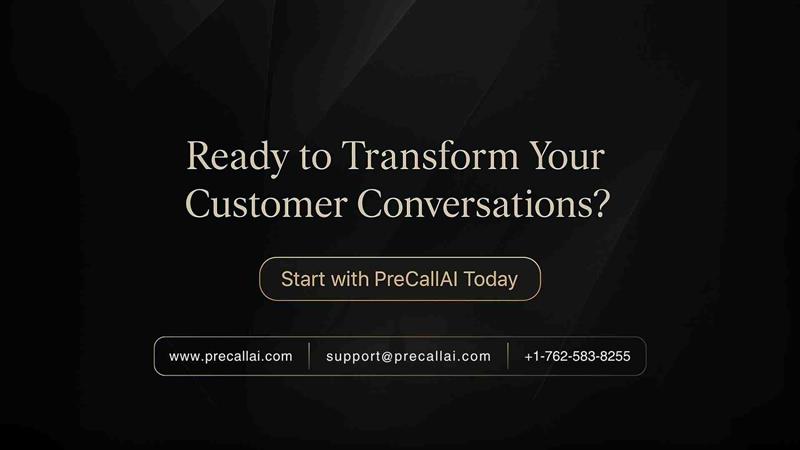
The competitive advantage of AI tools is undeniable now. Early adopters have proven remarkable results. Waiting puts you further behind competitors.
Choosing among the top seven options requires assessment. Your specific needs guide the right selection. Each platform excels in different areas.
Start with one tool and master it completely. Add complexity only after proving initial success. Methodical implementation prevents overwhelm.
Subscription AI software for outbound lead generation delivers measurable results quickly. Most companies see positive ROI within months. The investment is justified by returns.
Your sales team will adapt faster than expected. Initial resistance fades when results appear. Success creates enthusiasm and adoption.
Take advantage of free trials extensively. Hands-on experience reveals the best fit. Testing prevents expensive mistakes.
The future of sales is already here today. AI tools are becoming table stakes. Your prospects expect modern, efficient communication.
Your competitors are implementing these tools now. The question isn’t whether to adopt AI. It’s how quickly you can move.
Lead generation has been transformed permanently. Manual prospecting is increasingly obsolete. Adopt the tools that amplify human effort.
Revenue growth awaits on the other side. Take the first step with confidence. Subscription AI software for outbound lead generation will transform your results completely.


